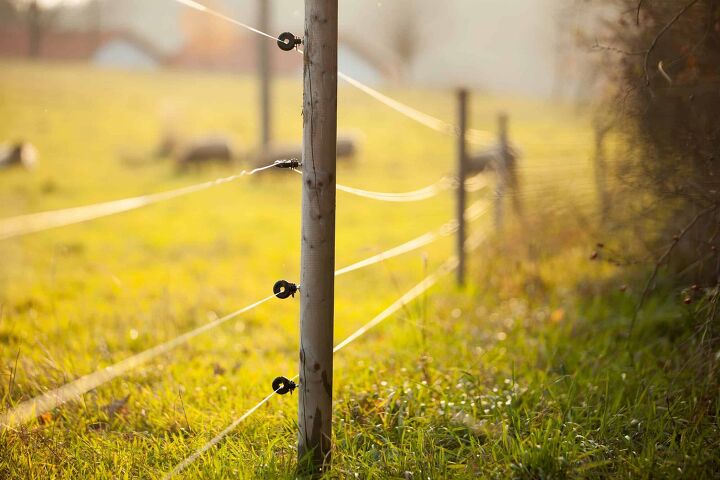Does An Electric Fence Need To Make A Complete Loop?

Have you ever driven through the countryside, through farming areas? You may have passed by farms with vast fields set far apart from the barn. How do farmers contain their animals in a setup like this? How did the electric fence span the whole area of the field when the barn so far away? Doesn’t an electric fence have to create a loop for it to work?
An electric fence does not need to make a complete loop, but the electrical current does. Electric fences with a full loop are often more effective because the current is stronger. A continuous loop electric fence can be confusing because digital fault finders will struggle to determine the amperage.
The best way to understand how an electric fence works is to know how electricity works itself. So, to bring some shocking knowledge to you lets delve back into eleventh-grade physics.
Do You Need an Electric Pet Fence Installed?
Get free, zero-commitment quotes from pro contractors near you.

What Is A Circuit?
A circuit is defined as “A complete and closed path around which a circulating electric current can flow.” There are different types of circuits, some are basic, and some are complex. The complex circuits can be found inside of your computer or phone.
A basic circuit is a simple circuit. A good example is a flashlight or electric fence. They have one path of electricity to do one job, and then the electricity is adequately dispersed.
How Does An Electrical Current Work?
Knowing the components that go into making an electric circuit is one thing. However, you must understand how the actual electric current is conducted. By understanding this, it will help keep you and anyone else that is near it safe.
The transformer, or your battery, is the start of the current. This is usually kept within the barn. It is plugged into an electrical outlet that supplies it with power. This power is then transformed into an electrical stimulus.
Conduction Of The Current
There are two sides to the transformer, just like a battery, both positive and negative. The positive side of the transformer is connected to your conductor or the wire for the fence.
The electricity is then pulsed through the wire to create the electrical current. The current is conducted the whole way through the wire to the end of it. The grounding wire must be installed to complete the current and make the fence viable.
Grounding
The grounding wire is installed into the ground six feet down and ten feet apart. The grounding wire then conducts the electricity back to the negative side of the transformer. This gives the electricity a safe place to go to be dispersed out of the circuit, thus creating a complete electrical loop.
What Are The Components Of An Electrical Circuit For A Fence?
For an electric fence to work, it needs to create an electrical circuit. The three components required for this to be successful are:
- A power source
- A transformer that acts as a battery
- Wire for the fencing
- Grounding wires
The fence is only as strong as the grounding wires that are in place. The weaker the grounding wires are then, the less likely the animals will feel any effect from the fence. This makes the fence powerless because the grounding wire completes the circuit.
Does an Electric Fence Have to Make a Complete Loop?
In short, an electric fence does not have to make a complete loop. However, there are associated pros and cons to choosing to complete the loop on your electric fence. When you create a continuous loop, power is pushed in both directions, increasing the voltage on the fence line. In this case, with a complete loop, the voltage now has to travel half of the distance.
Although more voltage is best, a continuous loop causes some challenges when you need to fault fine the fence line. Since the voltage is traveling in two directions, a digital fault finder has difficulty distinguishing left from right to determine where the amperage drop is.
With that being said, it is not required for your electric fence to make a complete loop. Only do so if your goal is to increase the voltage on the line.
What Happens When An Animal Or A Human Touches The Fence?
When an animal or a human touches the fence, they, of course, will get shocked. What happens is they become a part of the circuit.
If you are going out into the field to tend to the animals, you should think about unplugging the fence. This way, no electrical current is running through it. It would be considered a “dead” wire, but it would ensure your safety while you are out in the field.
Becoming Part Of The Circuit
When someone or something touches the electric fence, the current still works the same. Except that the current is then redirected through the object that is touching the wire. The electrical current goes through them, thus creating a shock.
The current then goes into the ground, directed to the grounding wires. The more moisture that is in the ground, the more conductivity produced. This will create more of a shock to the animal or person that touched the wire.
Will Your Electric Fence Hurt Birds Or Squirrels?
If you are thinking of installing an electric fence, you may be worried about harming birds, squirrels, or other innocent wildlife. However, electric fences do not harm these particular animals.
To complete the circuit, the animal in question needs to be touching the ground. As you know, squirrels and birds only stand on the wire; they don’t touch the ground when they land on it. It’s the same thing with powerlines. If you were to grab onto a power line, you would be fine unless your feet were on the ground.
Electric Fence Regulations
Warning signs and regulations can vary from state to state and even country to county. The regulations are pretty standard, although it is still recommended to check with your local ordinances before installing your fence.
Insulated cables must be used when connecting the ground system to the transformer. This will ensure the wires do not touch the structure to prevent a fire hazard. The ground system and the transformer cannot be connected to any other grounding device nor disused water pipes.
Spacing
The fence should be at least 133 feet away from any other electrical system or telephone system. It should also not be attached or ran under any power lines. If power lines are unavoidable, then the fence should run at ninety-degree angles and go underneath it. If this happens, then the fence wire should not be higher than approximately six feet above the ground.
Electric Fences In Populated Areas
If the fence within reach of the public, warning signs must be attached to it. These warning signs must be at a minimum of eight by four inches in size and intervals of no more than 295 feet. The sign must warn that the fence is electric, and any lettering should be at least an inch high. The sign needs to be yellow, and the wording should be black.
Related Questions
Will an electric fence kill you?
Fences that are used for farming and such will not kill you. Even if the voltage is high, the amps are extremely low. It only takes 1/10th of an amp to kill someone. However, electric fences have lower amperage than that. However, if you have a pacemaker, you should refrain from touching an electric fence.
Does a complete loop make your fence stronger?
In a short answer, no. What matters is that the electric current completes the loop. As long as you have a strong ground wire, then the current will be sufficient. The fence itself has nothing to do with the strength of the circuit.
How far apart should electric fence wires be?
Placing electric fence wires too close to each other is a common mistake that should be avoided. You should keep your wires at least five inches apart.
What happens if you don’t ground an electric fence?
When you install an electric fence, it is crucial that you set up a proper ground system. When an animal touches the electric fence wire, it will feel the current as the charge passes through its body. The circuit is then completed via the ground rod in the soil and then travels up the ground wire to the terminal charger.If the ground terminal charger and the animal are not properly grounded, the electric current cannot be completed and there won’t be any shock.
Do You Need an Electric Pet Fence Installed?
Get free, zero-commitment quotes from pro contractors near you.

Wrapping It Up
An electric fence does not need to make a complete loop; only the current does. The only reason you may consider making a continuous loop with your electric fence is to increase the voltage on the line. Otherwise, it’s simply not necessary.
If you are thinking of putting up an electric fence, make sure you adhere to local ordinances, especially if it’s near a populated area. Some states require you to put up warning signs if you install one. Check to see what your particular regulations are before installation.

Heather is a passionate writer who loves anything DIY. Growing up, she learned everything from home repairs to design, and wants to share her tips with you. When she's not writing, she's usually hiking or searching for her next DIY project.
More by Heather Robbins













![10 Best Zero Turn Mowers – [2022 Reviews & Ultimate Buyer's Guide]](https://cdn-fastly.upgradedhome.com/media/2023/07/31/9070522/10-best-zero-turn-mowers-2022-reviews-ultimate-buyer-s-guide.jpg?size=350x220)













